Vet Med Hackathon Fosters Interdisciplinary Thinking to Solve Common Problem Faced by Cat Owners: Feline House Soiling
October 23, 2018

A team discusses their ideas for a solution.
Having issues with your cat, Fluffy, peeing on your favorite rug? You’re not alone. Hoping to come up with some solutions to this prevalent problem plaguing cat owners everywhere, two current veterinarians, Illinois College of Veterinary Medicine alums, Drs. Aaron Smiley (DVM ’07) and Brooke Fowler (DVM ’08), organized the recent Hackathon: Thinking Outside the Box About Feline House Soiling, which was held on Wednesday, October 10th. Sponsored by Purina, Elanco, Boehringer Ingelheim, and Medici, the Hackathon offered a $2,500 grand prize as an incentive, which attracted 39 participants interesting in coming up with a solution (and winning the prize).
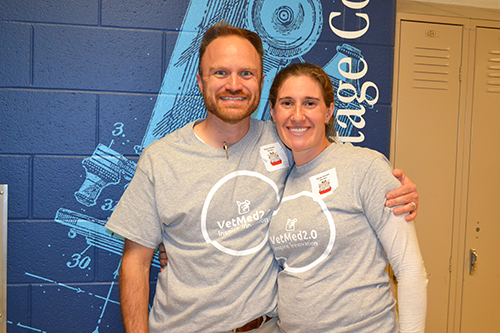
Drs. Aaron Smiley (left) and Brooke Fowler (right) during the Hackathon.
In the world today, one of the most common reasons for house cats being relinquished to shelters is having urinary issues which cause them to soil in the house outside their litter box. In fact, it can be very difficult for some cats to learn how to properly use a litter box, which can make them rather unappealing for owners who are unable to put in the extra time to deal with the issue. Fowler, who is a veterinary oncologist in private practice at a specialty hospital in Boulder, Colorado, and Smiley, who has a practice in Indiana, have realized the significance of this problem and have an idea for why a quality solution has yet to be found. They think that this problem still exists because of the way the typical veterinarian thinks.
“In veterinary medicine, we are trained to assimilate information and come up with one solution,” says Dr. Fowler. “But maybe for some of these problems that we were taught were unsolvable, maybe what we need to do is come up with a solution by starting at the problem and thinking in the other direction.”
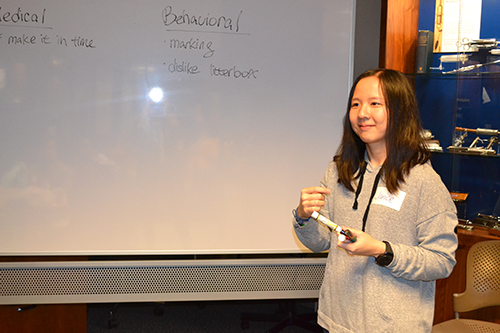
A member of the first place MeowApp! team writes their ideas on a white board.
As a result, the two believe that one way to come up with a solution might be to get people from other disciplines involved. So, they decided to return to their alma mater to host a hackathon, which is a contest designed for people to team up and use technology to solve a problem. The idea was for specialists in a variety of disciplines, including computer science, engineering, architecture, design, and, of course, veterinary medicine, to work together to find a way to help cats who are not using their litter box.
“We wanted to bring divergent thinking into vet med,” said Dr. Smiley, “so vets who are classically trained in convergent thinking are able to interchange creative thoughts and solutions to problems that are very difficult to solve.”
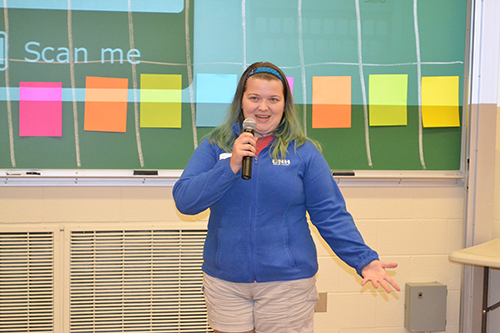
A Hackathon participant pitches her idea, which eventually became the third place runner up team, Cat in the Box.
The hackathon featured a total of 39 participants of very diverse backgrounds, ranging from Illinois computer science students to the CEO of a local gravel company! They all decided to attend for a variety of reasons. For example, Mandy Erdei, a vet student at Illinois, attended because “inappropriate elimination is something that can get a lot of cats kicked out of their homes and into shelters,” she said. “It’s really important to get a better handle on the issue; hopefully we can have more cats with permanent homes.”
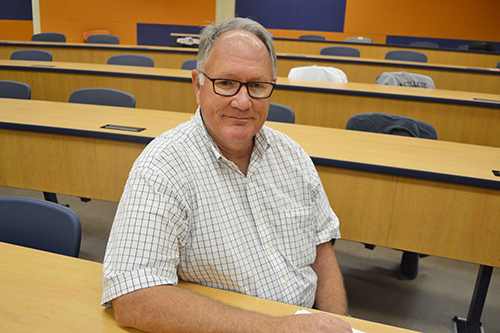
Local civil engineer Hugh Gallivan, who attended the hackathon.
On the other hand, local civil engineer Hugh Gallivan attended because he was interested in the hackathon aspect of the event. Gallivan helped organize a hackathon for the Pygmalion festival, and he came to this one because he is “interested in software and how that might apply to this problem.”

The Pixo team (who placed second with their SCRATCH app) working on their design ideas.
Attendees also included a team from Pixo, a tech consultancy in Urbana. One member, Allie Ofisher, has actually had similar problems with her own cat. In fact, she was in the process of training her cat to use a toilet, when a guest discovered the cat using the toilet. Ofisher reports that the cat would never use it again, and she didn’t think it was worth it to start the process over. Another member was Jason Berg, Director of Business Development at Pixo. Berg had done some research prior to the event, and was intrigued by the fact that they had to “come up with a solution to this that also meets the behaviorist guidelines of not creating any level of trauma for the cat. So you can't negatively reinforce things, so the exercise to come up with some positive reinforcement is going to be a good one.”
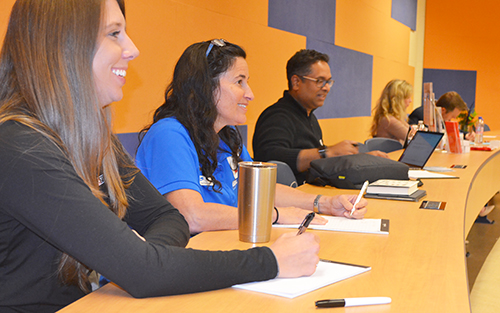
The panel of judges at the Vet Med Hackathon.
The hackathon began with a short introduction by Smiley and Fowler, followed by some information presented by Rachel Switzky, the director of the new Siebel Design Center. Her goal was to introduce participants to ideation, which involves looking at the end user when designing a solution to a problem. All participants were guided through this in the beginning, then had a chance to individually present their ideas so teams could form around them. Once teams were formed, there was a finite amount of time designated for working together to solve the problem before they presented their solution to the judges.
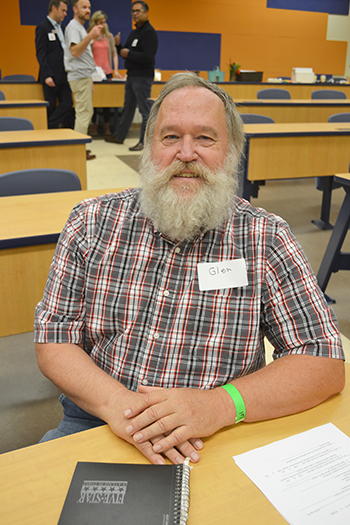
A Hackathon participant, retired electrician Glen Roberts of Champaign who participated in the Hackathon because he has had cats before, and thought that he would come to see what he could come up with.
Before they began developing a solution, participants were asked to consider a series of questions, to which Smiley responded, that would help them better understand both cats and their owners. Some of the questions included:
- What is the recommended size of a litter box?
- Are there any alternatives to litter boxes?
- What is it about peeing on soft things on the ground?
- How else do cats mark their territory?
- Is it typical to not contact a vet about litter box issues?
- Do cat owners usually resign themselves to these behaviors?
- How is trauma diagnosed and treated in cats?
- Do cats get angry? Do they pee out of spite?
- Why are some cats more adaptable than others?

Two participants who attened the Vet Med Hackathon.
Many teams opted to create websites or mobile applications which helped educate cat owners and diagnose problems. After coming up with creative, cutesy names for their solutions, such as SCRATCH, EduCATion, Dr P-Little, Cat in the Box, and LITTERAL APEEAL: THE PURRFECT BOX, teams then presented their ideas to a group of prestigious judges who evaluated the ideas based on the following criteria: originality, plausibility, solves the problem, and presentation.
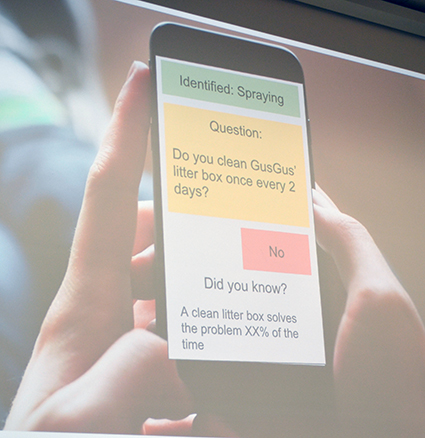
An example of MeowApp's user interface shown during their final presentation PowerPoint.
At the end of the day, a group of Illinois computer science students took home the grand prize for designing a mobile application called “MeowApp!” which had a platform that would ask cat owners questions to help diagnose the problem, and included a machine-learning algorithm which gathered data from strategically-placed cameras to monitor cats’ household elimination habits and a well-thought-out business model.
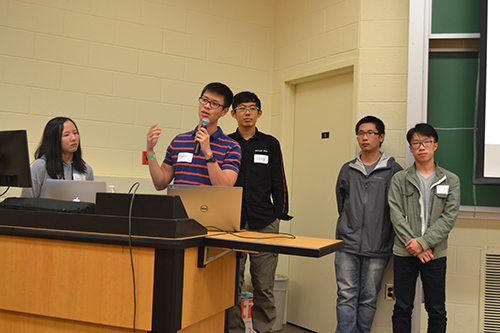
The winning team giving their presentation about their MeowApp!” design.
When asked about the ultimate goal of the event, both Fowler and Smiley were hoping for a new way of thinking to emerge among the participants. Smiley cited the importance of working across disciplines.
"I'm excited to allow the veterinary students to engage with the rest of campus...We're excited to bring the power of U of I across disciplines so that the institution among each college can talk to each other and realize the resources that are available to them.”
Fowler hoped that by the time the event concluded, all 39 participants “or whoever signs up, walks out of that room at 9 o'clock, whether they did or did not win, and think differently about the problems that they face. I hope that they have changed the way that they think,” and maybe even come up with an idea that is “so brilliant and earth shattering that Purina themselves have to take it and run with it!”
Story by Patrick Pavilonis. Photographs by Elizabeth Innes, Communications Specialist, I-STEM Education Initiative.
More: Vet Med, 2018
Following are additional I-STEM articles about Vet Med:
- 2018 Vet Med Open House Gives Visitors Up-Close and Hands-On Introduction to Animals, Veterinary Medicine
- 2015 Vet Med Open House Offers Visitors Hands-On Learning Opportunities
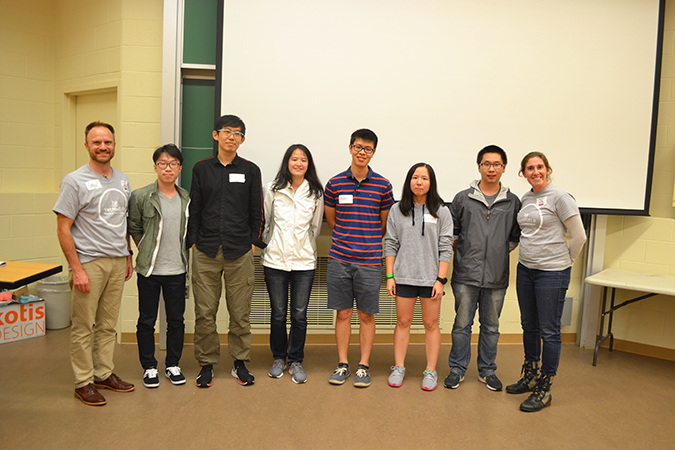
The winning team of the Vet Med Hackathon with Dr. Smiley and Dr. Fowler.













.jpg)
















